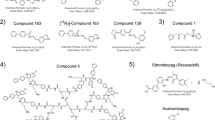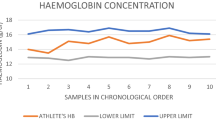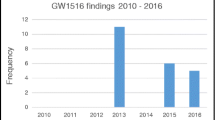Abstract
The administration of recombinant human erythropoietin (rhEPO) increases the maximum oxygen consumption capacity, and is therefore abused as a doping method in endurance sports. The detection of erythropoietin (EPO) abuse is based on direct pharmacological and indirect haematological approaches, both of which have several limitations. In addition, current detection methods cannot cope with the emerging doping strategies of EPO mimicry, analogues and gene doping, and thus novel detection strategies are urgently needed. Direct detection methods for EPO misuse can be either pharmacological approaches that identify exogenous substances based on their physicochemical properties, or molecular methods that recognise EPO transgenes or gene transfer vectors. Since direct detection with molecular methods requires invasive procedures, it is not appropriate for routine screening of large numbers of athletes. In contrast, novel indirect methods based on haematological and/or molecular profiling could be better suited as screening tools, and athletes who are suspect of doping would then be submitted to direct pharmacological and molecular tests. This article reviews the current state of the EPO doping field, discusses available detection methods and their shortcomings, outlines emerging pharmaceutical and genetic technologies in EPO misuse, and proposes potential directions for the development of novel detection strategies.
Similar content being viewed by others
Notes
1 The use of trade names is for product identification purposes only and does not imply endorsement.
References
Loeb Classical Library. Homer the Iliad (translated by Murray AT). Cambridge (MA): Harvard University Press, 1925: 551–3
Noakes TD. Tainted glory: doping and athletic performance. N Engl J Med 2004 Aug 26; 351 (9): 847–9
Fisher JW. Erythropoietin: physiology and pharmacology update. Exp Biol Med (Maywood) 2003 Jan; 228 (1): 1–14
Lacombe C, Mayeux P. The molecular biology of erythropoietin. Nephrol Dial Transplant 1999; 14 Suppl. 2: 22–8
Chong ZZ, Kang JQ, Maiese K. Angiogenesis and plasticity: role of erythropoietin in vascular systems. J Hematother Stem Cell Res 2002 Dec; 11 (6): 863–71
Gaudard A, Varlet-Marie E, Bressolle F, et al. Drugs for increasing oxygen and their potential use in doping: a review. Sports Med 2003; 33 (3): 187–212
Eagleton HJ, Littlewood TJ. Update on the clinical use and misuse of erythropoietin. Curr Haematol Rep 2003 Mar; 2 (2): 109–15
Fukuda MN, Sasaki H, Lopez L, et al. Survival of recombinant erythropoietin in the circulation: the role of carbohydrates. Blood 1989 Jan; 73 (1): 84–9
Egrie JC, Browne JK. Development and characterization of novel erythropoiesis stimulating protein (NESP). Nephrol Dial Transplant 2001; 16 Suppl. 3: 3–13
Lasne F, de Ceaurriz J. Recombinant erythropoietin in urine. Nature 2000 Jun 8; 405 (6787): 635
Aventis Pharma. Dynepo product update: DynepoTM (epoietin delta) Gene Activated® Erythropoietin [online]. Available from URL: http://www.tktx.com/legal/PDFs/Product_update.pdf [Accessed 2004 Aug 10]
Wilber RL. Detection of DNA-recombinant human epoetin-alfa as a pharmacological ergogenic aid. Sports Med 2002; 32 (2): 125–42
Parisotto R, Wu M, Ashenden MJ, et al. Detection of recombinant human erythropoietin abuse in athletes utilizing markers of altered erythropoiesis. Haematologica 2001 Feb; 86 (2): 128–37
Sharpe K, Hopkins W, Emslie KR, et al. Development of reference ranges in elite athletes for markers of altered erythropoiesis. Haematologica 2002 Dec; 87 (12): 1248–57
Gore CJ, Parisotto R, Ashenden MJ, et al. Second-generation blood tests to detect erythropoietin abuse by athletes. Haematologica 2003 Mar; 88 (3): 333–44
Parisotto R, Ashenden MJ, Gore CJ, et al. The effect of common haematologic abnormalities on the ability of blood models to detect erythropoietin abuse by athletes. Haematologica 2003 Aug; 88 (8): 931–40
Lasne F, Martin L, Crepin N. Detection of isoelectric profiles of erythropoietin in urine: differentiation of natural and administered recombinant hormones. Anal Biochem 2002 Dec 15; 311 (2): 119–26
Kochendoerfer GG, Chen SY, Mao F, et al. Design and chemical synthesis of a homogeneous polymer-modified erythropoiesis protein. Science 2003 Feb 7; 299 (5608): 884–7
Wells JA. Hormone mimicry. Science 1996 Jul 26; 273 (5274): 449–50
Tilbrook PA, Klinken SP. The erythropoietin receptor. Int J Biochem Cell Biol 1999 Oct; 31 (10): 1001–5
Tilbrook PA, Klinken SP. Erythropoietin and erythropoietin receptor. Growth Factors 1999; 17 (1): 25–35
Barbone FP, Johnson DL, Farrell FX, et al. New epoetin molecules and novel therapeutic approaches. Nephrol Dial Transplant 1999; 14 Suppl. 2: 80–4
Qureshi SA, Kim RM, Konteatis Z, et al. Mimicry of erythropoietin by a nonpeptide molecule. Proc Natl Acad Sci U S A 1999 Oct 12; 96 (21): 12156–61
Pascual JA, Belalcazar V, de Bolos C, et al. Recombinant erythropoietin and analogues: a challenge for doping control. Ther Drug Monit 2004 Apr; 26 (2): 175–9
Woodburn KW, Fan Q, Leuther KK, et al. Preclinical evaluation of Hematide™, a novel erythropoietic receptor agonist for the treatment of anemia caused by kidney disease [abstract no. 2904]. 46th Annual American Society of Hematology Meeting; 2004 Dec 4–7; San Deigo (CA)
Yi T, Zhang J, Miura O, et al. Haematopoietic cell phosphatase associates with erythropoietin (Epo) receptor after Epo-induced receptor tyrosine phosphorylation: identification of potential binding sites. Blood 1995 Jan 1; 85 (1): 87–95
Dalle B, Payen E, Regulier E, et al. Improvement of mouse beta-thalassemia upon erythropoietin delivery by encapsulated myoblasts. Gene Ther 1999 Feb; 6 (2): 157–61
Regulier E, Schneider BL, Deglon N, et al. Continuous delivery of human and mouse erythropoietin in mice by genetically engineered polymer encapsulated myoblasts. Gene Ther 1998 Aug; 5 (8): 1014–22
Rinsch C, Dupraz P, Schneider BL, et al. Delivery of erythropoietin by encapsulated myoblasts in a genetic model of severe anemia. Kidney Int 2002 Oct; 62 (4): 1395–401
Unal M, Ozer Unal D. Gene doping in sports. Sports Med 2004; 34 (6): 357–62
Svensson EC, Black HB, Dugger DL, et al. Long-term erythropoietin expression in rodents and non-human primates following intramuscular injection of a replication-defective adenoviral vector. Hum Gene Ther 1997 Oct 10; 8 (15): 1797–806
Danko I, Williams P, Herweijer H, et al. High expression of naked plasmid DNA in muscles of young rodents. Hum Mol Genet 1997 Sep; 6 (9): 1435–43
Johnston J, Tazelaar J, Rivera VM, et al. Regulated expression of erythropoietin from an AAV vector safely improves the anemia of beta-thalassemia in a mouse model. Mol Ther 2003 Apr; 7 (4): 493–7
Abruzzese RV, Godin D, Mehta V, et al. Ligand-dependent regulation of vascular endothelial growth factor and erythropoietin expression by a plasmid-based autoinducible GeneSwitch system. Mol Ther 2000 Sep; 2 (3): 276–87
Ye X, Rivera VM, Zoltick P, et al. Regulated delivery of therapeutic proteins after in vivo somatic cell gene transfer. Science 1999 Jan 1; 283 (5398): 88–91
Oxford Bio Medica. Successful preclinical results for new anaemia product [online]. Available from URL: http://www.oxfordbiomedica.co.uk/news/2002-ob-05.htm [Accessed 2004 Aug 10]
Adam D. Gene therapy may be up to speed for cheats at 2008 Olympics. Nature 2001 Dec 6; 414 (6864): 569–70
McCrory P. Super athletes or gene cheats? Br J Sports Med 2003 Jun; 37 (3): 192–3
Lasne F, Martin L, de Ceaurriz J, et al. ‘Genetic doping’ with erythropoietin cDNA in primate muscle is detectable. Mol Ther 2004 Sep; 10 (3): 409–10
Ooi SL, Shoemaker DD, Boeke JD. A DNA microarray-based genetic screen for nonhomologous end-joining mutants in Saccharomyces cerevisiae. Science 2001 Dec 21; 294 (5551): 2552–6
Malcovati L, Pascutto C, Cazzola M. Haematologic passport for athletes competing in endurance sports: a feasibility study. Haematologica 2003 May; 88 (5): 570–81
Perou CM, Sorlie T, Eisen MB, et al. Molecular portraits of human breast tumours. Nature 2000 Aug 17; 406 (6797): 747–52
Kolbus A, Blazquez-Domingo M, Carotta S, et al. Cooperative signaling between cytokine receptors and the glucocorticoid receptor in the expansion of erythroid progenitors: molecular analysis by expression profiling. Blood 2003 Nov 1; 102 (9): 3136–46
Gubin AN, Njoroge JM, Bouffard GG, et al. Gene expression in proliferating human erythroid cells. Genomics 1999 Jul 15; 59 (2): 168–77
DePrimo SE, Wong LM, Khatry DB, et al. Expression profiling of blood samples from an SU5416 Phase III metastatic colorectal cancer clinical trial: a novel strategy for biomarker identification. BMC Cancer 2003 Feb 7; 3 (1): 3
Twine NC, Stover JA, Marshall B, et al. Disease-associated expression profiles in peripheral blood mononuclear cells from patients with advanced renal cell carcinoma. Cancer Res 2003 Sep 15; 63 (18): 6069–75
Acknowledgements
No sources of funding were used to assist in the preparation of this manuscript. The authors have no potential conflicts of interest that are directly relevant to the contents of this manuscript.
Author information
Authors and Affiliations
Corresponding author
Rights and permissions
About this article
Cite this article
Diamanti-Kandarakis, E., Konstantinopoulos, P.A., Papailiou, J. et al. Erythropoietin Abuse and Erythropoietin Gene Doping. Sports Med 35, 831–840 (2005). https://doi.org/10.2165/00007256-200535100-00001
Published:
Issue Date:
DOI: https://doi.org/10.2165/00007256-200535100-00001




